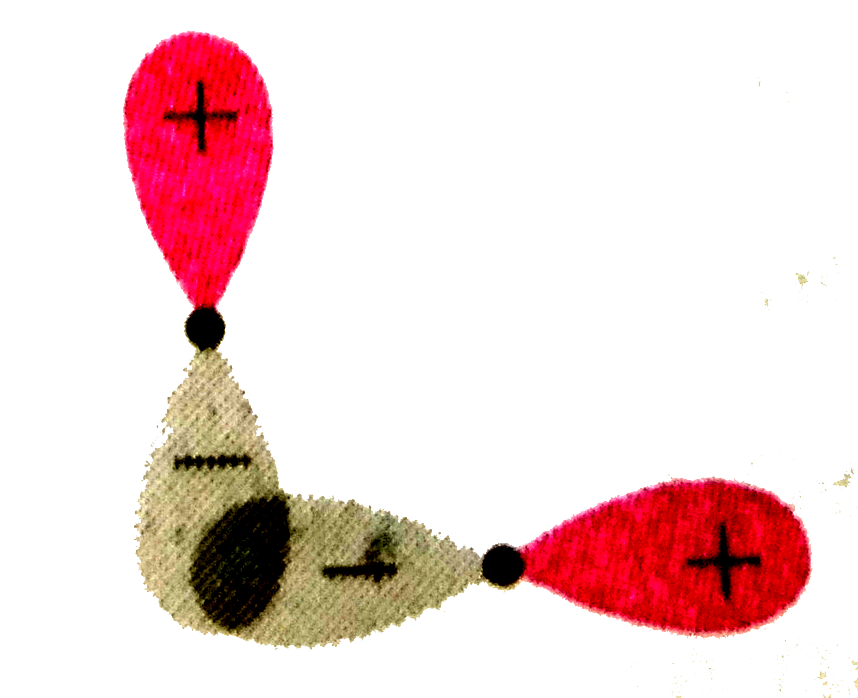According to VBT the extent of overlapping depends upon types of orbitals involved in overlapping and nature of overlapping. More will be the overlapping and the bond energy will also be high.
Which of the following combination of orbitals does not form covalent bond (x-axis is inter nuclear axis) :
s+py
py+py
dyz+dyz
dxy+dxy
The correct Answer is:A
To determine which combination of orbitals does not form a covalent bond according to Valence Bond Theory (VBT), we need to analyze the given combinations of orbitals based on their overlapping characteristics.
1. Understanding Covalent Bond Formation:
- Covalent bonds are formed when atomic orbitals overlap. The extent of this overlap determines the bond strength and type of bond formed (sigma, pi, or delta).
2. Analyzing the First Combination (s and p_y):
- The s orbital is spherical and can overlap along the internuclear axis (x-axis).
- The p_y orbital is oriented perpendicular to the x-axis.
- Since the s orbital cannot overlap sidewise with the p_y orbital, this results in non-bonding overlap.
- Conclusion: This combination does not form a covalent bond.
3. Analyzing the Second Combination (p_y and p_y):
- Both p_y orbitals are oriented along the y-axis.
- They can overlap sidewise, allowing for bonding interactions.
- Conclusion: This combination can form a covalent bond.
4. Analyzing the Third Combination (d_yz and d_yz):
- The d_yz orbitals are oriented in the yz-plane.
- They can overlap significantly as they are parallel to each other.
- This results in a strong overlap, potentially forming a delta bond.
- Conclusion: This combination can form a covalent bond.
5. Analyzing the Fourth Combination (d_xy and d_xy):
- The d_xy orbitals are oriented in the xy-plane.
- They can also overlap effectively, allowing for bonding interactions.
- This can lead to the formation of a pi bond.
- Conclusion: This combination can form a covalent bond.
6. Final Conclusion:
- Among the combinations analyzed, the only combination that does not form a covalent bond is the first one: s and p_y.
Answer:
The combination of orbitals that does not form a covalent bond is s and p_y.
---
- Covalent bonds are formed when atomic orbitals overlap. The extent of this overlap determines the bond strength and type of bond formed (sigma, pi, or delta).
- The s orbital is spherical and can overlap along the internuclear axis (x-axis).
- The p_y orbital is oriented perpendicular to the x-axis.
- Since the s orbital cannot overlap sidewise with the p_y orbital, this results in non-bonding overlap.
- Conclusion: This combination does not form a covalent bond.
- Both p_y orbitals are oriented along the y-axis.
- They can overlap sidewise, allowing for bonding interactions.
- Conclusion: This combination can form a covalent bond.
- The d_yz orbitals are oriented in the yz-plane.
- They can overlap significantly as they are parallel to each other.
- This results in a strong overlap, potentially forming a delta bond.
- Conclusion: This combination can form a covalent bond.
- The d_xy orbitals are oriented in the xy-plane.
- They can also overlap effectively, allowing for bonding interactions.
- This can lead to the formation of a pi bond.
- Conclusion: This combination can form a covalent bond.
- Among the combinations analyzed, the only combination that does not form a covalent bond is the first one: s and p_y.
The combination of orbitals that does not form a covalent bond is s and p_y.
Topper's Solved these Questions
- BOOK - VK JAISWAL ENGLISHCHAPTER - CHEMICAL BONDING (BASIC)EXERCISE - Level 3 (Passive 11)6videos
CHEMICAL BONDING (BASIC)
- BOOK - VK JAISWAL ENGLISHCHAPTER - CHEMICAL BONDING (BASIC)EXERCISE - Level 3 (Passive 12)4videos
CHEMICAL BONDING (BASIC)
- BOOK - VK JAISWAL ENGLISHCHAPTER - CHEMICAL BONDING (BASIC)EXERCISE - Level 3 (Passive 9)6videos
CHEMICAL BONDING (BASIC)
- BOOK - VK JAISWAL ENGLISHCHAPTER - CHEMICAL BONDING (ADVANCED)EXERCISE - SUBJECTIVE PROBLEMS64videos
CHEMICAL BONDING (ADVANCED)
- BOOK - VK JAISWAL ENGLISHCHAPTER - CO-ORDINATION COMPOUNDSEXERCISE - LEVEL 2144videos
CO-ORDINATION COMPOUNDS
Similar Questions
According to VBT the extent of overlapping depends upon types of orbitals involved in overlapping and nature of overlapping. More will be the overlapping and the bond energy will also be high.
Which of the following compound does not form pπ−pπ bond ?View SolutionWhich of the following combination of orbitals do / does not form bond (if x-axis is internuclear axis) ?
View Solution
Knowledge Check
- Question 1 - Select One
Which of the following orbitals will not form sigma bond after overlapping ?
As - orbital and s- orbitalBs- orbital and pz− orbitalCpz- orbital and pz− orbitalDpx-orbital and px- orbital - Question 2 - Select One
Which of the following orbital overlapping is not possible according to VBT?
A B
B C
C DAll of these
DAll of these
According to VBT the extent of overlapping depends upon types of orbitals involved in overlapping and nature of overlapping. More will be the overlapping and the bond energy will also be high.
The incorrect order of bond dissociation energy will be :View SolutionAccording to VBT the extent of overlapping depends upon types of orbitals involved in overlapping and nature of overlapping. More will be the overlapping and the bond energy will also be high.
The incorrect order of bond dissociation energy will be :View SolutionWhich of the following combination of orbitals can not form bond. (If x axis in internuclear axis)
View SolutionWhich of the following overlaps of atomic orbitals does not form π-bond if z-axis is the internuclear axis?
View SolutionWhat type of orbitals can overlap to form a covalent bond?
View SolutionDoes hydrogen bonding involved the overlapping in atomic orbital ?
View Solution

